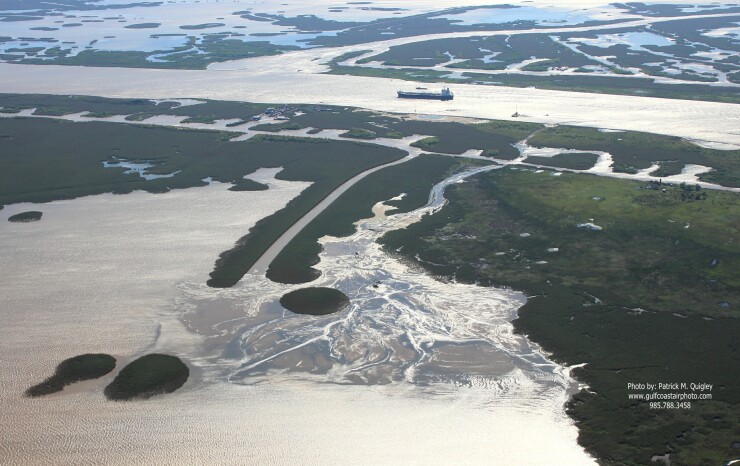Executives of the Port of South Louisiana thought they got lucky at a Washington, D.C., forum on infrastructure in December 2016.
Ohio real estate developer Dan Slane was in the audience, scouting for worthy infrastructure projects for the Trump transition team. And the port’s Mississippi River dredging project landed on
At the time, port Executive Director Paul Aucoin said, it appeared that dredging the shipping channel, where vessel depth restrictions jeopardize tens of thousands of jobs, had gained recognition as a high priority from the incoming administration.

A year later, however, the nation is looking to Trump’s state of the union address Tuesday for detail on his trillion dollar infrastructure plan, and Slane says his list is “going nowhere.” The dredging project still lacks the federal funding it needs, and the White House has questioned the U.S. government’s backing for the first project on Slane’s list – the Gateway rail tunnel project between New York City and Newark, N.J.
Slane, who remains passionate about his solutions for America’s infrastructure problems, has rented an apartment in Washington as a base as he tries to persuade lawmakers and the White House to take up his proposal.
“So far, I’m not making much progress,” he said in an interview this month with The Bond Buyer.
That’s because Slane said he believes the two former Wall Street executives in charge of infrastructure - White House chief economic advisor Gary Cohn and infrastructure policy special assistant to the president D.J. Gribbin – are focused primarily on public-private partnerships.
Slane said P3s aren’t suitable for all projects and can drive up costs compared with financing with municipal bonds.
An infrastructure funding plan purportedly leaked by the White House this month is a recipe for failure, Slane said, because it leaves out elements he believes are critical for any plan to be successful.
Although the leaked plan lays out funding principles and formulas, including broader use of private activity bonds, Slane said it fails to address the need to shorten permitting procedures or obtain an emergency authorization to begin work from Congress.
The plan doesn’t address revising legal standards to prevent abusive lawsuits, and it lacks focus on funding projects that are national in scope, leaving decisions to the states, he said.
Using his experience as a real estate developer, Slane said he devised his infrastructure report “with a professional point of view.” He flew around the country vetting projects, but said he wasn’t paid.
When he asked the National Governor’s Association to suggest one or two projects, “They sent me 750,” he said. “Most were rejected because they weren’t national in scope.”
Then he had to overcome the distrust of Congress, who he said has been “lied to” in the past about the kinds of infrastructure projects financed with federal money and how many jobs would be created.
Remember the “bridge to nowhere” in Alaska? he asked.
To verify the job numbers cited in his report – it says 193,350 long-term jobs would be created directly from the 50 projects recommended, and another 241,700 jobs would be created indirectly – Slane said he enlisted Boston Consulting and CG/LA Infrastructure to do the math.
In addition to creating a list of projects that would benefit the nation as a whole, he said other issues need to be addressed for infrastructure projects to move forward efficiently. “We need relief from permitting,” he said. “What's the point of solving the infrastructure funding problem if we can't get projects permitted?”
Under the National Environmental Policy Act, it can take up to 10 years for a project to go through studies and permitting; it should take months, he said.
Also needed is “relief from lawsuits that are predatory and abusive,” he said, citing environmental groups as particularly troublesome. “They delay and extract a pound of flesh.”
Slane wants to tighten the statute of limitations to bring legal challenges, a requirement for litigants to post a bond when they appeal a project’s permit, and more leeway for the courts to dismiss suits.
Slane credited the administration for starting to reform the permitting process internally, and for addressing what he believes is lawsuit abuse.
Finally, Slane said he suggested a commission similar to that in the Base Realignment and Closure process for military bases should be created to free infrastructure projects from politics.
“It would go to congress, and they'd have to accept the whole list with no amendments,” he said.
The administration’s belief is that the states should develop the projects, a view with which he disagrees.
“We can help the country but it's complicated,” he said. “Trying to convince people to do this the right way is not easy.”
As for his priority list, Slane also said he’d like a chance to revise his report to clarify some language and put projects in order of priority. Although numbered, the 50 projects are not in order of importance.
The report says the combined the projects would cost $137.5 billion and private investment would be 50%.
“I probably should have been clearer on that, and said 50% of those projects could be funded with private funding,” he said. “This whole thing went viral in January all over world. Saudis, Norwegians are all trying to invest.”
Half of the projects would not attract private investors because there’s no ongoing funding stream such as a toll or a fee. For those, his plan proposed full federal funding.
If he could prioritize the projects now, Slane said the Soo Locks reconstruction in Michigan would be No. 1. It’s 43rd in the report.
The U.S. Army Corps of Engineers’ locks link Lakes Huron and Superior, which more than 4,500 vessels use each year to haul 80 million tons of cargo such as iron ore, wheat and limestone.
“The lock is 51-years-old and beyond its life’s capability,” Slane said. “If the lock goes down, 11 million people will lose jobs and there will be a number of bankruptcies.”
According to his report, building a larger replacement lock in place of two smaller locks would cost $580 million. The Corps’ website says design work will resume when funding is received from Congress.
Slane now sees the second-most important project as the Gateway rail tunnel plan that the Federal Transit Administration called into doubt in December.
The $12.7 billion project has received funding commitments of 25% each from New York and New Jersey governors. However, the FTA questioned the framework for those commitments and asked if the states intended to rely on the federal government for full funding.
Slane said U.S. Rep. Bill Shuster, R-Hollidaysburg, chairman of the U.S. House Transportation and Infrastructure Committee, “has been pushing hard for the tunnel…and it’s almost become a national issue fixing it.”

To say that the list created expectations would be an understatement. Slane said he’s constantly getting calls from project sponsors asking about it. “They are very frustrated,” he said.
The Mississippi River dredging project, for example, has a cost estimate of $237.7 million that requires Louisiana to contribute 25%, when the state has a $1 billion budget deficit. State officials say they are committed to the project and will find a way to fund it.
Under Slane’s plan, the channel dredging to 50 feet from 45 feet – authorized for decades – would cost the federal government $1 billion, because he believes the project should include 10 years of maintenance dredging.
Congress hasn’t allocated funding for the Corps to undertake the Mississippi River project from the Harbor Maintenance Tax, a 0.125% levy on imported commercial cargo. Why?
Congress diverted as much as $9.5 billion from the HMT trust fund since the tax was authorized in 1986, according to Slane and local port authorities. That’s a problem they hope to rectify.
On Jan. 10, the bipartisan congressional Problem Solvers caucus released a
Port director Aucoin hopes the administration and Congress accepts Slane’s plan allocating 100% of federal funding to the Mississippi River dredging project because more than 30 states depend on the channel for exporting agriculture products.
“What’s happened is Congress got caught up in healthcare and the tax plan,” Aucoin said. The hope is that infrastructure will be taken up next and “it will gain some traction again,” he said.
Thirteen of the “Emergency and National Security Projects” were seeking federal funding before President Trump took office. To date, 12 projects still are waiting for federal funds, while another one -- a $528 million Detroit M-1 rail expansion project -- was reduced in scope and completed.
Dallas Area Rapid Transit spokesman Morgan Lyons said that, unlike the Gateway project, DART has heard nothing about possible loss of federal funding for the $1.1 billion to $2.8 billion, 67.7-mile Cotton Belt rail project to connect suburbs north of Dallas to Dallas-Fort Worth International Airport.
"We’re continuing project development and are scheduled to be in operation in 2022," Lyons said. "We plan to seek a federal Railroad Rehabilitation and Improvement Financing loan."
Some portions of the $8 billion federally funded plan to repair or replace 15 structurally deficient bridges on Interstate 95 in Philadelphia remain unfunded, said Pennsylvania Department of Transportation spokesman Brad E. Rudolph.
“If additional federal funds became available, PennDOT could potentially use those resources to accelerate or assign funding to unfunded projects along I-95 and other highways across the region,” he said.
Although the Northeast Ohio Regional Sewer District is five years into Project Clean Lake, the 25-year, $3 billion federally mandated master plan for Cleveland, funding is in question.
“There hasn’t been a whole lot of movement on any kind of infrastructure funding,” District spokeswoman Jean Smith said. “Our program continues but there has been some discussion about having funding available at the federal level sometime in 2018.”
Drilling down to the bottom line, Slane suggests that his work may be a lost opportunity for the country and President Trump’s promise to create jobs – at least before mid-term elections are over this year.
“The stakes are high, because we are in an economic war with China and losing,” he said.
China’s $1 trillion infrastructure project called the One Belt One Road, he said, is a massive undertaking of highways, pipelines, transmission lines, ports, power stations, fiber optics, and railroads connecting China to Central Asia, Europe and Africa.
“It’s the largest infrastructure project initiated by one nation in the history of the world and is designed to enable China to become the dominant economic power in the world,” he said. “If we don’t get our act together very soon, we should all be brushing up on our Mandarin.”
What about jobs? Slane said creating jobs was among Trumps’ campaign promises, and helped him get elected.
Had the administration backed his plan last year, he said new jobs would be created by now.
“Now it’s sort of too late,” Slane said. “If they called me tomorrow I could create a lot of buzz, but no jobs until the end of the year.”
Paul Burton, Andrew Coen, Nora Colomer, Yvette Shields and Richard Williamson contributed to this article.





